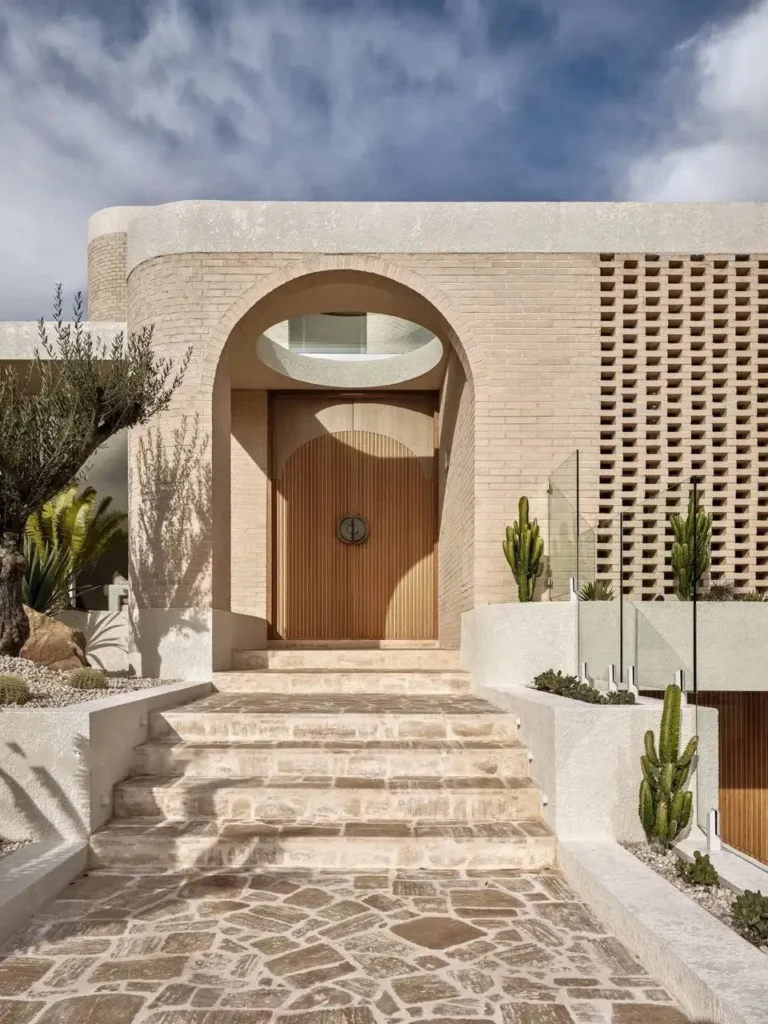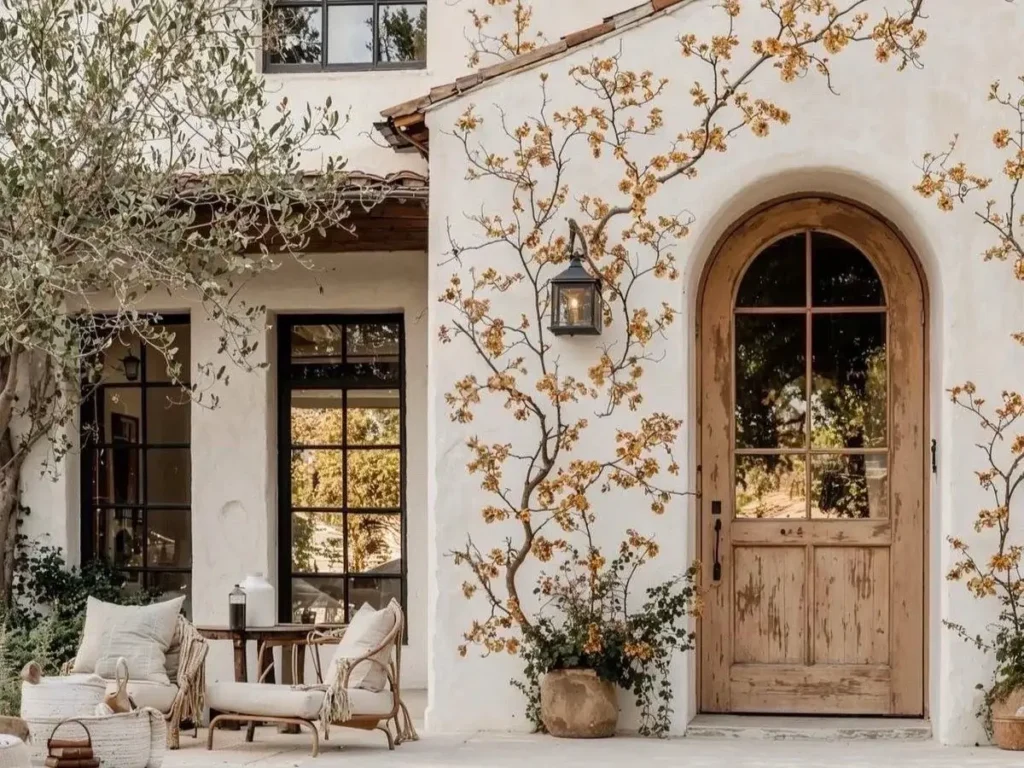Step into a world suffused with light, where natural warmth emanates from every surface – this is the essence of Modern Mediterranean home design. It’s a compelling style that beautifully marries the timeless appeal of classic Mediterranean villas with the refined simplicity of contemporary aesthetics. This modern interpretation embraces core elements like natural textures, graceful arches, and indoor-outdoor living, yet thoughtfully filters them through a lens of minimalism, functionality, and curated comfort. The result is an atmosphere that feels airy, grounded, and effortlessly sophisticated.
This guide explores the defining characteristics of modern Mediterranean home design, from its key architectural features and essential materials to its signature color palettes and styling nuances. Whether renovating or seeking fresh inspiration, discover how to cultivate this elegant balance of old-world charm and modern ease in your own living space.

What Is Modern Mediterranean Home Design?
Modern Mediterranean home design is essentially a contemporary evolution of the styles found in homes bordering the Mediterranean Sea. While drawing inspiration from the rich history and relaxed lifestyle of regions like Greece, Italy, and Spain, it reinterprets these influences for today’s living. It focuses on creating bright, airy spaces that seamlessly blend indoor comfort with outdoor beauty.

Unlike purely traditional approaches, the modern interpretation emphasizes cleaner lines, functional layouts, and a more minimalist approach to decoration, while still cherishing core elements like natural materials, textured finishes, and architectural details like arches. It’s about capturing the timeless Mediterranean feeling – warmth, light, connection to nature – within a sophisticated, contemporary framework. While rooted in tradition, it readily incorporates modern luxuries and energy-efficient design principles.

Key Elements of Modern Mediterranean Design
Several essential elements define the modern Mediterranean aesthetic, creating its signature look and feel:
- Emphasis on Indoor-Outdoor Living: Prioritizing a seamless flow between interior and exterior spaces through large windows, sliding glass doors, courtyards, and well-appointed patios or pool areas.
- Arches and Curves: Incorporating graceful arches in doorways, windows, and interior niches, along with curved walls or furniture details, to soften lines and add architectural interest.
- Textured Walls and Surfaces: Utilizing tactile finishes like stucco, plaster, lime wash, or light-toned brick to add depth, warmth, and visual interest through the interplay of light and shadow.
- Natural Materials: Generous use of materials drawn from nature, such as stone (marble, limestone, travertine) for counters and paving, warm woods (like oak) for flooring and cabinetry, and natural fibers (linen, cotton, rattan, jute) for textiles and accents.
- Warm Neutral Color Palette: Building upon a foundation of whites, creams, beiges, taupes, and soft grays, complemented by earthy tones from wood and stone, and occasional muted accents inspired by the sea and sky.
- Minimalist-Chic Styling: Focusing on uncluttered spaces, quality over quantity, and decor chosen for its sculptural form, natural material, or textural quality. Emphasizes comfort and functionality without excess ornamentation.

Modern Mediterranean Interior Design Tips


Consider these tips to effectively incorporate the modern Mediterranean style into your home:
Walls
- Opt for shades of warm white, cream, or light beige to maximize light and create an airy feel.
- Embrace textured finishes like plaster, lime wash, or microcement for depth and character.
- Allow natural imperfections or variations in the finish to show through for an authentic, artisanal touch.
- Incorporate or highlight arched niches or doorways as focal points.

Flooring
- Choose natural materials like light wood (consider patterns like herringbone), stone tiles, or polished concrete for continuity.
- Aim for the same flooring throughout main living areas to enhance flow and spaciousness.
- Use flat-weave rugs made from natural fibers (jute, sisal) in muted tones to add softness and texture underfoot without overwhelming the space.

Furniture & Decor
- Select furniture with clean lines combined with soft or curved silhouettes; prioritize comfort and natural materials like wood, linen, and rattan.
- Keep decor minimal and purposeful. Focus on sculptural items like ceramic vases, wooden bowls, or statement lighting with organic shapes.
- Incorporate natural elements: use potted olive trees, lemon trees, figs, or sculptural cacti if climate permits, or display simple branches or dried botanicals in rustic vessels.
- Use open shelving sparingly in kitchens or living areas to display curated ceramics or glassware, adding personality without clutter.
- Introduce texture through throws, cushions, and woven baskets.
- Consider large, simple mirrors, perhaps with arched or pill shapes, to reflect light and echo architectural forms.

Lighting
- Maximize natural light wherever possible.
- Choose light fixtures made from natural or textured materials like ceramic, plaster, wood, or rattan.
- Incorporate architectural lighting, such as cove lighting or integrated LED strips in niches, to create ambiance.
- Use warm metallic finishes (brass, bronze) or matte black for fixtures.
Windows & Doors
- Keep window treatments light and airy – think sheer linen curtains or minimal roller shades that allow light to filter through.
- Highlight architectural features like arched windows or substantial wooden entrance doors.
- Utilize large sliding or French doors to maximize the connection to outdoor spaces.
Outdoor Spaces
- Treat patios, balconies, or pool decks as extensions of the interior living space.
- Use durable, natural materials like stone pavers or wood decking.
- Furnish outdoor areas comfortably with pieces that echo the interior style, using weather-resistant natural materials where possible.
- Incorporate drought-tolerant Mediterranean landscaping like olive trees, lavender, succulents, and ornamental grasses.

Modern Mediterranean home design offers a unique synthesis of warmth, light, and sophisticated comfort. By harmonizing natural materials, tactile surfaces, and graceful architectural forms with contemporary clarity and function, it creates spaces that feel both enduringly stylish and perfectly attuned to modern life. Celebrating nature, craftsmanship, and a relaxed sense of luxury, this aesthetic crafts personal sanctuaries that are as inviting and comfortable as they are beautiful – a timeless expression of the Mediterranean spirit reimagined for today.

FAQs
What’s the key difference between modern and traditional Mediterranean design?
Modern Mediterranean design streamlines traditional forms, emphasizing clean lines, curated minimalism, and functionality alongside classic elements like arches and natural textures. Traditional styles, in contrast, might incorporate more elaborate ornamentation and heavier architectural details.
What colors define the modern Mediterranean palette?
The core palette revolves around warm neutrals – think whites, creams, beiges, taupes, and soft grays. These are complemented by rich earthy tones drawn from natural materials like stone and wood. Subtle accents of muted blues or greens, inspired by the sea and sky, can be introduced sparingly.
What are three essential materials for achieving this look?
Key materials are central to the style’s identity. Prioritize: 1) Natural Stone (like marble, travertine, or limestone) for its texture and connection to the earth; 2) Warm Woods (such as oak) for flooring, cabinetry, or furniture to add organic warmth; and 3) Tactile Wall Finishes like plaster, stucco, or render to create depth and interact beautifully with light.



